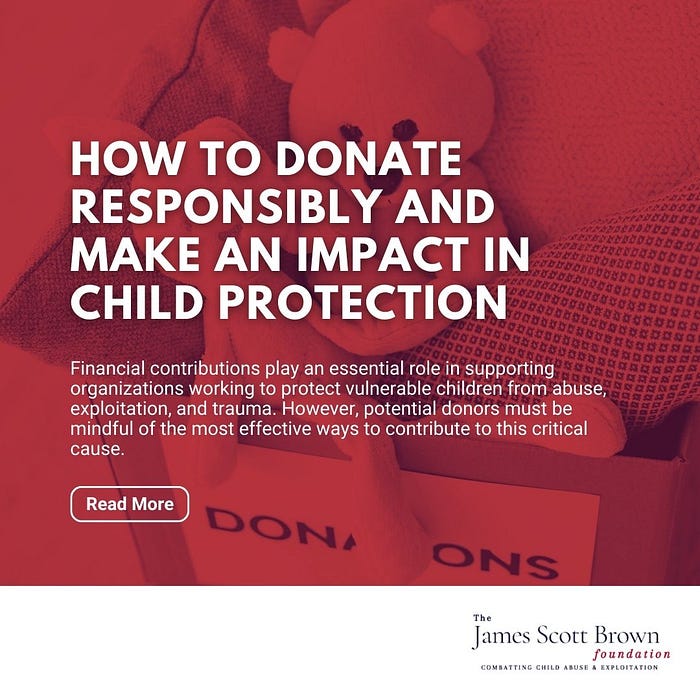How to Donate Responsibly and Make an Impact in Child Protection by James Scott Brown Foundation
by James Scott Brown Foundation

Abstract:
Financial contributions play an essential role in supporting organizations working to protect vulnerable children from abuse, exploitation, and trauma. However, potential donors must be mindful of the most effective ways to contribute to this critical cause. This article delves into the strategies for donating responsibly and ensuring that one’s contributions make a significant impact on child protection efforts. By understanding the importance of researching organizations, engaging in long-term giving, and supporting holistic approaches, donors can maximize their contributions and play a crucial role in safeguarding children’s futures.
Introduction:
The fight against child abuse, trauma, and exploitation necessitates the collaboration of various stakeholders, including nonprofit organizations, governments, and individual donors. Financial donations can bolster child protection efforts by providing resources to organizations striving to protect, support, and rehabilitate affected children. To ensure the responsible allocation of funds, donors must adopt a thoughtful approach to their contributions, considering the following recommendations.
1.Research Organizations:
Before donating, it is vital to conduct thorough research on organizations working in child protection to ensure they are credible, effective, and transparent (Sargeant & Lee, 2004). Potential donors should examine the organization’s mission, history, and impact, as well as its financial transparency and governance structure. Online resources, such as charity evaluators, can provide valuable insight into an organization’s performance and effectiveness.
2. Engage in Long-term Giving:
Sustained financial support can provide organizations with the stability they need to develop and maintain their programs and services (Bekkers & Wiepking, 2011). Adopting a long-term giving approach, such as setting up recurring donations, can help create lasting change in child protection efforts, ensuring the continued well-being of vulnerable children.
3. Support Holistic Approaches:
Child protection requires a comprehensive approach that encompasses prevention, intervention, and rehabilitation (Finkelhor, 2009). By supporting organizations that adopt a multifaceted strategy, donors can contribute to addressing the root causes and systemic challenges of child abuse, trauma, and exploitation. This may involve backing organizations that work in various sectors, such as education, healthcare, and policy advocacy.
4. Be Informed About the Use of Funds:
Understanding how an organization allocates its funds can help donors ensure their contributions are used effectively (Sargeant & Lee, 2004). Donors should examine an organization’s annual reports, financial statements, and program descriptions to gain insight into the use of funds and the impact of their programs.
5. Encourage Collaboration:
Supporting and promoting collaboration among organizations can lead to a more significant impact on child protection efforts (Finkelhor, 2009). By donating to organizations that work in partnership with other stakeholders, such as government agencies, community groups, and other nonprofits, individuals can help to create a unified approach to combating child abuse, trauma, and exploitation.
Conclusion:
Donating responsibly is crucial to ensuring that one’s contributions make a tangible difference in child protection efforts. By researching organizations, engaging in long-term giving, supporting holistic approaches, being informed about the use of funds, and encouraging collaboration, donors can maximize the impact of their donations and contribute significantly to the safeguarding of children’s futures.
References:
Bekkers, R., & Wiepking, P. (2011). A literature review of empirical studies of philanthropy: Eight mechanisms that drive charitable giving. Nonprofit and Voluntary Sector Quarterly, 40(5), 924–973.
Finkelhor, D. (2009). The prevention of childhood sexual abuse. The Future of Children, 19(2), 169–194.
Sargeant, A., & Lee, S. (2004). Trust and relationship commitment in the United Kingdom voluntary sector: Determinants of donor behavior. Psychology & Marketing, 21(8), 613–635.
Read more at the James Scott Brown Foundation.
Comments
Post a Comment